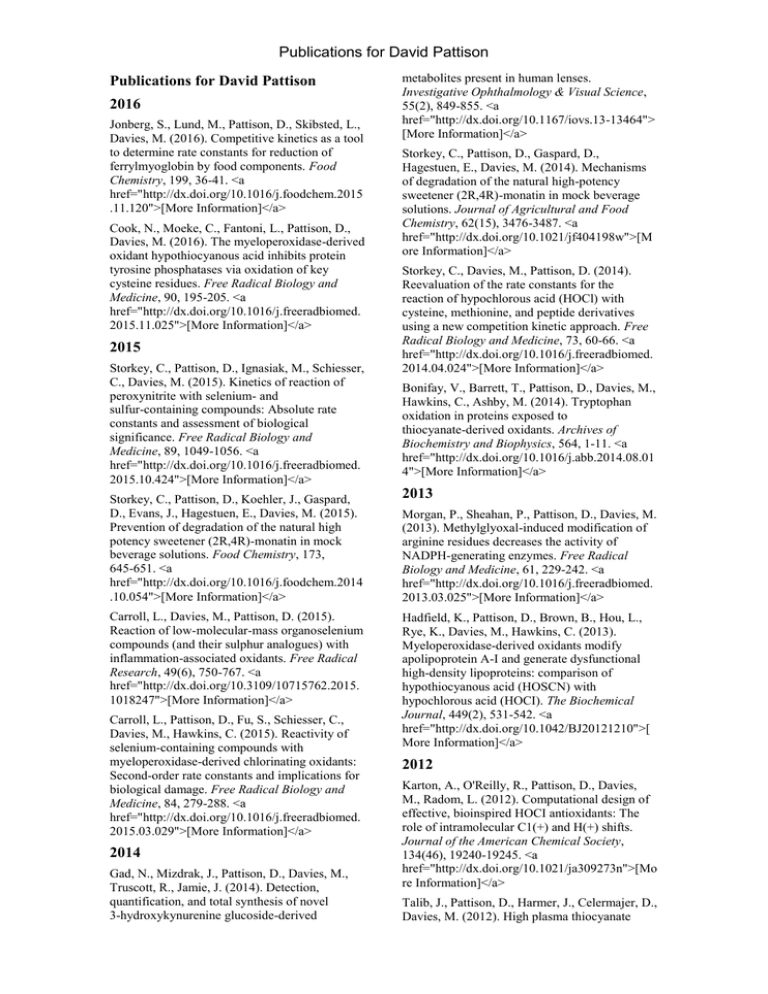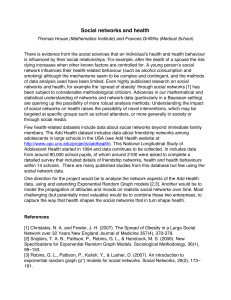Publications for David Pattison 2016
advertisement

Publications for David Pattison Publications for David Pattison 2016 Jonberg, S., Lund, M., Pattison, D., Skibsted, L., Davies, M. (2016). Competitive kinetics as a tool to determine rate constants for reduction of ferrylmyoglobin by food components. Food Chemistry, 199, 36-41. <a href="http://dx.doi.org/10.1016/j.foodchem.2015 .11.120">[More Information]</a> Cook, N., Moeke, C., Fantoni, L., Pattison, D., Davies, M. (2016). The myeloperoxidase-derived oxidant hypothiocyanous acid inhibits protein tyrosine phosphatases via oxidation of key cysteine residues. Free Radical Biology and Medicine, 90, 195-205. <a href="http://dx.doi.org/10.1016/j.freeradbiomed. 2015.11.025">[More Information]</a> 2015 Storkey, C., Pattison, D., Ignasiak, M., Schiesser, C., Davies, M. (2015). Kinetics of reaction of peroxynitrite with selenium- and sulfur-containing compounds: Absolute rate constants and assessment of biological significance. Free Radical Biology and Medicine, 89, 1049-1056. <a href="http://dx.doi.org/10.1016/j.freeradbiomed. 2015.10.424">[More Information]</a> Storkey, C., Pattison, D., Koehler, J., Gaspard, D., Evans, J., Hagestuen, E., Davies, M. (2015). Prevention of degradation of the natural high potency sweetener (2R,4R)-monatin in mock beverage solutions. Food Chemistry, 173, 645-651. <a href="http://dx.doi.org/10.1016/j.foodchem.2014 .10.054">[More Information]</a> Carroll, L., Davies, M., Pattison, D. (2015). Reaction of low-molecular-mass organoselenium compounds (and their sulphur analogues) with inflammation-associated oxidants. Free Radical Research, 49(6), 750-767. <a href="http://dx.doi.org/10.3109/10715762.2015. 1018247">[More Information]</a> Carroll, L., Pattison, D., Fu, S., Schiesser, C., Davies, M., Hawkins, C. (2015). Reactivity of selenium-containing compounds with myeloperoxidase-derived chlorinating oxidants: Second-order rate constants and implications for biological damage. Free Radical Biology and Medicine, 84, 279-288. <a href="http://dx.doi.org/10.1016/j.freeradbiomed. 2015.03.029">[More Information]</a> 2014 Gad, N., Mizdrak, J., Pattison, D., Davies, M., Truscott, R., Jamie, J. (2014). Detection, quantification, and total synthesis of novel 3-hydroxykynurenine glucoside-derived metabolites present in human lenses. Investigative Ophthalmology & Visual Science, 55(2), 849-855. <a href="http://dx.doi.org/10.1167/iovs.13-13464"> [More Information]</a> Storkey, C., Pattison, D., Gaspard, D., Hagestuen, E., Davies, M. (2014). Mechanisms of degradation of the natural high-potency sweetener (2R,4R)-monatin in mock beverage solutions. Journal of Agricultural and Food Chemistry, 62(15), 3476-3487. <a href="http://dx.doi.org/10.1021/jf404198w">[M ore Information]</a> Storkey, C., Davies, M., Pattison, D. (2014). Reevaluation of the rate constants for the reaction of hypochlorous acid (HOCl) with cysteine, methionine, and peptide derivatives using a new competition kinetic approach. Free Radical Biology and Medicine, 73, 60-66. <a href="http://dx.doi.org/10.1016/j.freeradbiomed. 2014.04.024">[More Information]</a> Bonifay, V., Barrett, T., Pattison, D., Davies, M., Hawkins, C., Ashby, M. (2014). Tryptophan oxidation in proteins exposed to thiocyanate-derived oxidants. Archives of Biochemistry and Biophysics, 564, 1-11. <a href="http://dx.doi.org/10.1016/j.abb.2014.08.01 4">[More Information]</a> 2013 Morgan, P., Sheahan, P., Pattison, D., Davies, M. (2013). Methylglyoxal-induced modification of arginine residues decreases the activity of NADPH-generating enzymes. Free Radical Biology and Medicine, 61, 229-242. <a href="http://dx.doi.org/10.1016/j.freeradbiomed. 2013.03.025">[More Information]</a> Hadfield, K., Pattison, D., Brown, B., Hou, L., Rye, K., Davies, M., Hawkins, C. (2013). Myeloperoxidase-derived oxidants modify apolipoprotein A-I and generate dysfunctional high-density lipoproteins: comparison of hypothiocyanous acid (HOSCN) with hypochlorous acid (HOCI). The Biochemical Journal, 449(2), 531-542. <a href="http://dx.doi.org/10.1042/BJ20121210">[ More Information]</a> 2012 Karton, A., O'Reilly, R., Pattison, D., Davies, M., Radom, L. (2012). Computational design of effective, bioinspired HOCI antioxidants: The role of intramolecular C1(+) and H(+) shifts. Journal of the American Chemical Society, 134(46), 19240-19245. <a href="http://dx.doi.org/10.1021/ja309273n">[Mo re Information]</a> Talib, J., Pattison, D., Harmer, J., Celermajer, D., Davies, M. (2012). High plasma thiocyanate Publications for David Pattison levels modulate protein damage induced by myeloperoxidase and perturb measurement of 3-chlorotyrosine. Free Radical Biology and Medicine, 53(1), 20-29. <a href="http://dx.doi.org/10.1016/j.freeradbiomed. 2012.04.018">[More Information]</a> Barrett, T., Pattison, D., Leonard, S., Carroll, K., Davies, M., Hawkins, C. (2012). Inactivation of thiol-dependent enzymes by hypothiocyanous acid: role of sulfenyl thiocyanate and sulfenic acid intermediates. Free Radical Biology and Medicine, 52(6), 1075-1085. <a href="http://dx.doi.org/10.1016/j.freeradbiomed. 2011.12.024">[More Information]</a> Cook, N., Pattison, D., Davies, M. (2012). Myeloperoxidase-derived oxidants rapidly oxidize and disrupt zinc-cysteine/histidine clusters in proteins. Free Radical Biology and Medicine, 53(11), 2072-2080. <a href="http://dx.doi.org/10.1016/j.freeradbiomed. 2012.09.033">[More Information]</a> Pattison, D., Rahmanto, A., Davies, M. (2012). Photo-oxidation of proteins. Photochemical and Photobiological Sciences, 11(1), 38-53. <a href="http://dx.doi.org/10.1039/c1pp05164d">[ More Information]</a> Rahmanto, A., Pattison, D., Davies, M. (2012). Photo-oxidation-induced inactivation of the selenium-containing protective enzymes thioredoxin reductase and glutathione peroxidase. Free Radical Biology and Medicine, 53(6), 1308-1316. <a href="http://dx.doi.org/10.1016/j.freeradbiomed. 2012.07.016">[More Information]</a> Storkey, C., Pattison, D., White, J., Schiesser, C., Davies, M. (2012). Preventing Protein Oxidation with Sugars: Scavenging of Hypohalous Acids by 5-Selenopyranose and 4-Selenofuranose Derivatives. Chemical Research in Toxicology, 25(11), 2589-2599. <a href="http://dx.doi.org/10.1021/tx3003593">[M ore Information]</a> Morgan, P., Pattison, D., Davies, M. (2012). Quantification of hydroxyl radical-derived oxidation products in peptides containing glycine, alanine, valine, and proline. Free Radical Biology and Medicine, 52(2), 328-339. <a href="http://dx.doi.org/10.1016/j.freeradbiomed. 2011.10.448">[More Information]</a> Pattison, D., Davies, M., Hawkins, C. (2012). Reactions and reactivity of myeloperoxidase-derived oxidants: Differential biological effects of hypochlorous and hypothiocyanous acids. Free Radical Research, 46(8), 975-995. <a href="http://dx.doi.org/10.3109/10715762.2012. 667566">[More Information]</a> Skaff, O., Pattison, D., Morgan, P., Bachana, R., Jain, V., Priyadarsini, I., Davies, M. (2012). Selenium-containing amino acids are targets for myeloperoxidase-derived hypothiocyanous acid: determination of absolute rate constants and implications for biological damage. The Biochemical Journal, 441(1), 305-316. <a href="http://dx.doi.org/10.1042/BJ20101762">[ More Information]</a> Pattison, D., Lam, M., Shinde, S., Anderson, R., Davies, M. (2012). The nitroxide TEMPO is an efficient scavenger of protein radicals: Cellular and kinetic studies. Free Radical Biology and Medicine, 53, 1664-1674. <a href="http://dx.doi.org/10.1016/j.freeradbiomed. 2012.08.578">[More Information]</a> 2011 Morgan, P., Pattison, D., Talib, J., Summers, F., Harmer, J., Celermajer, D., Hawkins, C., Davies, M. (2011). High plasma thiocyanate levels in smokers are a key determinant of thiol oxidation induced by myeloperoxidase. Free Radical Biology and Medicine, 51(9), 1815-1822. <a href="http://dx.doi.org/10.1016/j.freeradbiomed. 2011.08.008">[More Information]</a> Pattison, D., O'Reilly, R., Skaff, O., Radom, L., Anderson, R., Davies, M. (2011). One-electron Reduction of N-chlorinated and N-Brominated Species Is a Source of Radicals and Bromine Atom Formation. Chemical Research in Toxicology, 24(3), 371-382. <a href="http://dx.doi.org/10.1021/tx100325z">[Mo re Information]</a> 2010 Stanley, N., Pattison, D., Hawkins, C. (2010). Ability of Hypochlorous Acid and N-Chloramines to Chlorinate DNA and Its Constituents. Chemical Research in Toxicology, 23(7), 1293-1302. <a href="http://dx.doi.org/10.1021/tx100188b">[M ore Information]</a> Koelsch, M., Mallak, R., Graham, G., Kajer, T., Milligan, M., Nguyen, L., Newsham, D., Keh, J., Kettle, A., Scott, K., Pattison, D., Hawkins, C., Davies, M., et al (2010). Acetaminophen (paracetamol) inhibits myeloperoxidase-catalyzed oxidant production and biological damage at therapeutically achievable concentrations. Biochemical Pharmacology, 79(8), 1156-1164. <a href="http://dx.doi.org/10.1016/j.bcp.2009.11.02 4">[More Information]</a> Szuchman-Sapir, A., Pattison, D., Davies, M., Witting, P. (2010). Site-specific hypochlorous acid-induced oxidation of recombinant human myoglobin affects specific amino acid residues and the rate of cytochrome b(5)-mediated heme Publications for David Pattison reduction. Free Radical Biology and Medicine, 48(1), 35-46. <a href="http://dx.doi.org/10.1016/j.freeradbiomed. 2009.09.023">[More Information]</a> 2009 Skaff, O., Pattison, D., Davies, M. (2009). Hypothiocyanous acid reactivity with low-molecular-mass and protein thiols: absolute rate constants and assessment of biological relevance. Biochemical Journal, 422(1), 111-117. <a href="http://dx.doi.org/10.1042/BJ20090276">[ More Information]</a> Gracanin, M., Hawkins, C., Pattison, D., Davies, M. (2009). Singlet-oxygen-mediated amino acid and protein oxidation: formation of tryptophan peroxides and decomposition products. Free Radical Biology and Medicine, 47(1), 92-102. <a href="http://dx.doi.org/10.1016/j.freeradbiomed. 2009.04.015">[More Information]</a> Pattison, D., Hawkins, C., Davies, M. (2009). What are the plasma targets of the oxidant hypochlorous acid? A kinetic modeling approach. Chemical Research in Toxicology, 22(5), 807-817. <a href="http://dx.doi.org/10.1021/tx800372d">[M ore Information]</a> 2008 Szuchman-Sapir, A., Pattison, D., Ellis, N., Hawkins, C., Davies, M., Witting, P. (2008). Hypochlorous acid oxidizes methionine and tryptophan residues in myoglobin. Free Radical Biology and Medicine, 45(6), 789-798. <a href="http://dx.doi.org/10.1016/j.freeradbiomed. 2008.06.010">[More Information]</a> Davies, M., Hawkins, C., Pattison, D., Rees, M. (2008). Mammalian heme peroxidases: from molecular mechanisms to health implications. Antioxidants & Redox Signaling, 10(7), 1199-1234. <a href="http://dx.doi.org/10.1089/ars.2007.1927"> [More Information]</a> Lam, M., Pattison, D., Bottle, S., Keddie, D., Davies, M. (2008). Nitric Oxide and Nitroxides Can Act as Efficient Scavengers of Protein-Derived Free Radicals. Chemical Research in Toxicology, 21(11), 2111-2119. <a href="http://dx.doi.org/10.1021/tx800183t">[Mo re Information]</a> Morgan, P., Pattison, D., Hawkins, C., Davies, M. (2008). Separation, detection, and quantification of hydroperoxides formed at side-chain and backbone sites on amino acids, peptides, and proteins. Free Radical Biology and Medicine, 45(9), 1279-1289. <a href="http://dx.doi.org/10.1016/j.freeradbiomed. 2008.08.004">[More Information]</a> Skaff, O., Pattison, D., Davies, M. (2008). The vinyl ether linkages of plasmalogens are favored targets for myeloperoxidase-derived oxidants: a kinetic study. Biochemistry, 47(31), 8237-8245. <a href="http://dx.doi.org/10.1021/bi800786q">[M ore Information]</a> Hawkins, C., Pattison, D., Stanley, N., Davies, M. (2008). Tryptophan residues are targets in hypothiocyanous acid-mediated protein oxidation. Biochemical Journal, 416(3), 441-452. <a href="http://dx.doi.org/10.1042/BJ20070941">[ More Information]</a> 2007 Hawkins, C., Pattison, D., Whiteman, M., Davies, M. (2007). Chlorination and nitration of DNA and nucleic acid components. In Evans M; Cooke M (Eds.), Oxidative Damage to Nucleic Acids, (pp. 14-39). United States: Springer. Pattison, D., Hawkins, C., Davies, M. (2007). Hypochlorous Acid-Mediated Protein Oxidation: How Important Are Chloramine Transfer Reactions and Protein Tertiary Structure? Biochemistry, 46(34), 9853-9864. <a href="http://www.ncbi.nlm.nih.gov/entrez/query. fcgi?cmd=Retrieve&db=pubmed&dopt=Abstract &list_uids=17676767">[More Information]</a> Skaff, O., Pattison, D., Davies, M. (2007). Kinetics of hypobromous acid-mediated oxidation of lipid components and antioxidants. Chemical Research in Toxicology, 20(12), 1980-1988. <a href="http://www.ncbi.nlm.nih.gov/entrez/query. fcgi?cmd=Retrieve&db=pubmed&dopt=Abstract &list_uids=18047295">[More Information]</a> 2006 Pattison, D., Davies, M. (2006). Actions of ultraviolet light on cellular structures. EXS, 96, 131-157. <a href="http://www.ncbi.nlm.nih.gov/entrez/query. fcgi?cmd=Retrieve&db=pubmed&dopt=Abstract &list_uids=16383017">[More Information]</a> Pattison, D., Davies, M. (2006). Evidence for rapid inter- and intramolecular chlorine transfer reactions of histamine and carnosine chloramines: implications for the prevention of hypochlorous-Acid-mediated damage. Biochemistry, 45(26), 8152-8162. <a href="http://www.ncbi.nlm.nih.gov/entrez/query. fcgi?cmd=Retrieve&db=pubmed&dopt=Abstract &list_uids=16800640">[More Information]</a> Pattison, D., Davies, M. (2006). Reactions of myeloperoxidase-derived oxidants with biological substrates: gaining chemical insight into human inflammatory diseases. Current Publications for David Pattison Medicinal Chemistry, 13(27), 3271-3290. <a href="http://www.ncbi.nlm.nih.gov/entrez/query. fcgi?cmd=Retrieve&db=pubmed&dopt=Abstract &list_uids=17168851">[More Information]</a> 2005 Pattison, D., Davies, M. (2005). Histidine side-chain chloramines are important intermediates in HOCL-mediated protein oxidation. 13th Biennial Meeting of the Society for Free Radical Research, United Kingdom: Taylor and Francis. Pattison, D., Davies, M. (2005). Kinetic analysis of the role of histidine chloramines in hypochlorous acid mediated protein oxidation. Biochemistry, 44(19), 7378-7387. <a href="http://www.ncbi.nlm.nih.gov/entrez/query. fcgi?cmd=Retrieve&db=pubmed&dopt=Abstract &list_uids=15882077">[More Information]</a> Rees, M., Pattison, D., Davies, M. (2005). Oxidation of heparan sulphate by hypochlorite: role of N-chloro derivatives and dichloramine-dependent fragmentation. Biochemical Journal, 391(Pt 1), 125-134. <a href="http://www.ncbi.nlm.nih.gov/entrez/query. fcgi?cmd=Retrieve&db=pubmed&dopt=Abstract &list_uids=15932347">[More Information]</a> 2004 Pattison, D., Davies, M. (2004). Kinetic Analysis Of The Reactions Of Hypobromous Acid With Protein Components: Implications For Cellular Damage And Use Of 3-Bromotyrosine As A Marker Of Oxidative Stress. Biochemistry, 43(16), 4799-4809. Levina, A., Foran, G., Pattison, D., Lay, P. (2004). X-Ray Absorption Spectroscopic And Electrochemical Studies Of Tris(Catecholato (2-))Chromate (V/I V/Iii) Complexes. Angewandte Chemie (International Edition), 43(4), 462-465. <a href="http://dx.doi.org/10.1002/anie.200352418" >[More Information]</a> 2003 Hawkins, C., Pattison, D., Davies, M. (2003). Hypochlorite-induced oxidation of amino acids, peptides and proteins. Amino Acids, 25(3-4), 259-274. <a href="http://dx.doi.org/10.1007/s00726-003-001 6-x">[More Information]</a> Pattison, D., Hawkins, C., Davies, M. (2003). Hypochlorous Acid-Mediated Oxidation of Lipid Components and Antioxidants Present in LowDensity Lipoproteins: Absolute Rate Constants, Product Analysis, and Computational Modeling. Chemical Research in Toxicology, 16(4), 439-449. 2002 Hawkins, C., Pattison, D., Davies, M. (2002). Reaction of protein chloramines with DNA and nucleosides: evidence for the formation of radicals, protein-DNA cross-links and DNA fragmentation. Biochemical Journal, 365(3), 605-615. 2001 Pattison, D., Levina, A., Lay, P., Davies, M. (2001). An investigation of the chromium oxidation state of a monoanionic chromium tris(catecholate) complex by X-ray absorption and EPR spectroscopies. Inorganic Chemistry, 40, 214-217. Pattison, D., Levina, A., Lay, P., Davies, M., Dixon, N. (2001). Chromium(VI) reduction by catechol(amine)s results in DNA cleavage in vitro: Relevance to chromium genotoxicity. Chemical Research in Toxicology, 14, 500-510.

